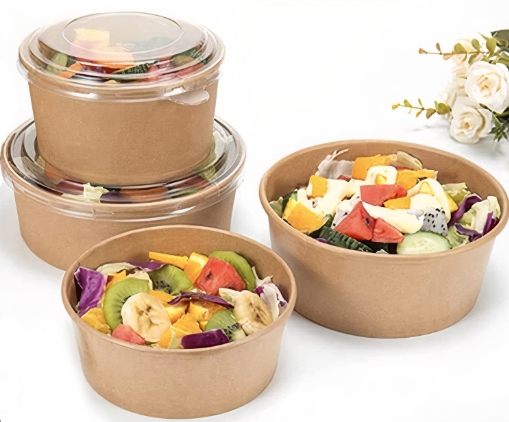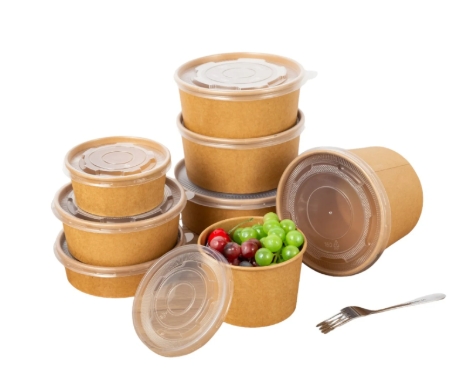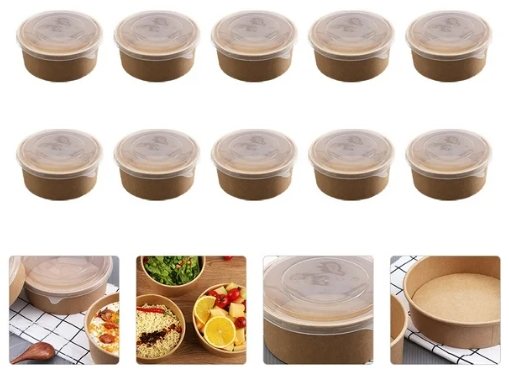
Content Menu
● Understanding Degradability
● Key Materials Used in Degradable Bowls and Lids
● The Manufacturing Process: A Step-by-Step Overview
>> Raw Material Preparation
>> Forming the Products
>> Drying and Heat-Setting
>> Trimming and Finishing
>> Quality Control and Testing
>> Packaging and Distribution
● Sustainable Practices in Degradable Bowl and Lid Manufacturing
● Challenges in the Production Process
● Future Trends in Degradable Food Packaging
● Conclusion
● FAQ
>> 1. What materials are commonly used to make degradable bowls and lids?
>> 2. Can degradable bowls and lids hold hot food and liquids?
>> 3. Are these products safe for microwave or refrigerator use?
>> 4. Are degradable bowls and lids the same as compostable?
>> 5. How should degradable bowls and lids be disposed of?
As environmental consciousness grows, businesses and consumers alike are shifting away from single-use plastics and embracing sustainable alternatives. One of the most promising options in eco-friendly dining is degradable bowl and lid sets. These products are designed to serve everyday convenience while breaking down naturally after disposal, leaving little to no environmental footprint. But have you ever wondered how they're made?
This comprehensive article takes you behind the scenes, exploring the entire manufacturing process — from gathering natural materials to forming, finishing, and packaging — and highlights the sustainable innovations and challenges shaping the industry. Whether you're a sustainability enthusiast, an entrepreneur, or simply curious, join us as we unfold the journey of degradable bowls and lids.

Understanding Degradability
Degradability refers to a material's ability to break down through natural processes, such as exposure to heat, moisture, and microorganisms. In contrast to traditional plastics that can linger in the environment for centuries, degradable materials return to the earth without leaving harmful residues.
These materials degrade in several ways, including:
- Biodegradation, where microbes consume the material as food;
- Composting, involving the breakdown under specific temperature and humidity conditions;
- Oxidative degradation, which involves exposure to oxygen and sunlight.
The final goal is always the same: reduce long-term waste and promote a circular lifecycle for disposable products.
Key Materials Used in Degradable Bowls and Lids
The materials chosen for these products are natural, renewable, and safe for both the user and the environment. Below are some commonly used components in degradable bowl and lid manufacturing:
- Bagasse: A fibrous residue left after extracting juice from sugarcane. It's lightweight, durable, and compostable.
- Bamboo fiber: Known for its strength and rapid growth cycle, bamboo is an ideal candidate for eco-friendly manufacturing.
- Wheat straw: The stalks remaining after harvesting wheat; a byproduct that's typically underutilized.
- Polylactic Acid (PLA): A biodegradable polymer derived from fermented plant starch, often used to add water-resistant or smooth textures.
By utilizing waste byproducts from agriculture, manufacturers not only reduce reliance on virgin materials but also help manage agricultural residue efficiently.
The Manufacturing Process: A Step-by-Step Overview
Creating a degradable bowl and lid set is far more complex than pouring pulp into a mold. It requires precision, technological coordination, and adherence to strict quality and environmental standards.
Raw Material Preparation
The process starts with sourcing and processing the raw materials. Agricultural fibers such as bagasse or bamboo are gathered, cleaned, and ground into a fine, uniform pulp. If PLA or other biopolymers are included, they are melted and blended to create a smooth, moldable consistency.
This stage ensures the base material is free from contaminants and ready for transformation into sturdy yet compostable items.
Forming the Products
Once the pulp is prepared, it is transferred to forming machines. These machines use molds shaped like bowls or lids which draw the pulp into shape using either pressure or vacuum suction. The even distribution of the pulp across the mold's surface prevents weak spots and ensures product integrity.
For products using PLA or starch-based bioplastics, an injection molding process may be used. In this method, heated biomass is injected into solid molds and then cooled, allowing intricate shapes and thin surfaces to be formed reliably.
Drying and Heat-Setting
Newly shaped items still contain high levels of moisture. They are removed from molds and placed in automated drying chambers or under controlled-heat rollers. Heat-setting solidifies the items and ensures they retain their intended shape.
To increase density and durability, some manufacturers follow this with a pressing stage that uses hot metal plates. This not only strengthens the surface but also smoothens texture and removes excess air bubbles from the material.
Trimming and Finishing
Once dried, the items go through trimming machines. These machines cut excess fibers, shape the edges, and fine-tune the overall dimensions of the bowl or lid. Aesthetic and functional coatings — usually made from natural or biodegradable elements — might be added to improve resistance to water, oil, or heat.
This stage contributes heavily to the usability of the final product. Consumers expect compostable bowls and lids to perform just as well as their plastic counterparts, especially when holding hot soup or greasy meals.
Quality Control and Testing
High standards of quality ensure durability, safety, and performance. Quality control checks involve:
- Structural strength tests: Simulating pressure from stacking or containing food.
- Liquid retention checks: Ensuring liquids and oils don't seep through.
- Temperature resistance: Testing against cold, ambient, and hot conditions.
- Visual inspection: Verifying consistency in size, shape, and finish.
Substandard products are either reprocessed into pulp or sent for composting, ensuring that defects don't add excess waste to production cycles.
Packaging and Distribution
Approved items are stacked and packed in cartons made from recycled cardboard or biodegradable wrapping. The packaging is designed to keep products clean, dry, and protected during transit. Labels often include composting instructions and certifications for environmental compliance.
Efficient logistics ensure the bowls and lids reach restaurants, cafes, grocery retailers, and end-users while maintaining their shape and condition.

Sustainable Practices in Degradable Bowl and Lid Manufacturing
Eco-friendly manufacturing goes beyond using compostable materials. Many producers implement green practices across their operations:
- Energy Efficiency: Using renewable energy sources or optimizing machine usage to reduce carbon emissions.
- Water Recycling: Treating and reusing water that was used to clean and process the raw fibers.
- Waste Reduction: Recycling offcuts from the trimming stage back into the pulping process.
- Eco-Friendly Packaging: Choosing cartons and tapes that degrade or can be reused.
Collectively, these practices help lower the environmental burden and enhance the credibility of companies involved in sustainable product development.
Challenges in the Production Process
While the shift toward degradable products is encouraging, there are hurdles that still need addressing:
- Cost Efficiency: The raw materials and machines used in eco-friendly production tend to be more expensive than those in traditional plastic manufacturing.
- Material Variability: Unlike synthetic polymers, plant-based fibers can vary in texture and performance, affecting final product quality.
- Regulatory Requirements: Meeting compostability standards and securing safety certifications can be resource-intensive.
- Shelf Life: Degradable products require proper storage to maintain integrity, especially in humid conditions.
Overcoming these challenges requires continuous research, supply chain optimization, and technological development.
Future Trends in Degradable Food Packaging
Innovation is at the heart of this evolving industry, and several exciting trends are shaping the future of degradable food packaging:
- Smart Coatings: New biodegradable coatings are being developed that improve resistance without leaving any legacy residues.
- Fully Compostable Packaging Sets: Next-generation packaging includes not just the bowl and lid but the label and the adhesive holding the label.
- Localized Sourcing: Manufacturers are investing in local agricultural waste as sources for fiber pulp, reducing carbon emissions and transportation costs.
- Automation and AI: Leveraging artificial intelligence in mold cleaning, quality testing, and production optimization.
These trends will ensure that biodegradable food packaging continues to meet market demands while raising performance standards and minimizing ecological costs.
Conclusion
The manufacturing process of degradable bowl and lid sets is a remarkable intersection of sustainability, science, and innovation. Every step — from selecting renewable raw materials to fine-tuning final trims — is part of a broader mission to create everyday items that align with long-term environmental goals.
As consumers become more eco-conscious and businesses strive for greener operations, degradable foodware is poised to take center stage in the future of dining, retail, and packaging. By understanding this process, we support informed choices that help sustain the planet for generations to come.

FAQ
1. What materials are commonly used to make degradable bowls and lids?
Degradable products are typically made from natural plant-based materials, such as sugarcane bagasse, wheat straw, or bamboo fiber. Some products may also include biodegradable polymers to provide added strength and resistance.
2. Can degradable bowls and lids hold hot food and liquids?
Yes, they are designed to withstand heat and contain both hot and cold foods. Some bowls may have an additional natural coating to prevent soaking or weakening when in contact with liquids.
3. Are these products safe for microwave or refrigerator use?
Many degradable items are safe for use in microwaves and refrigerators. However, it's important to follow manufacturer guidelines as extreme conditions may affect structural durability for some compositions.
4. Are degradable bowls and lids the same as compostable?
While all compostable products are degradable, not all degradable products are compostable under home conditions. Compostable items decompose into natural elements in a compost environment more quickly and without leaving harmful residues.
5. How should degradable bowls and lids be disposed of?
The ideal way to dispose of them is through composting — either at home (if the product is home compostable) or via industrial composting. If composting is not an option, they still break down more quickly in landfills compared to regular plastics.

















